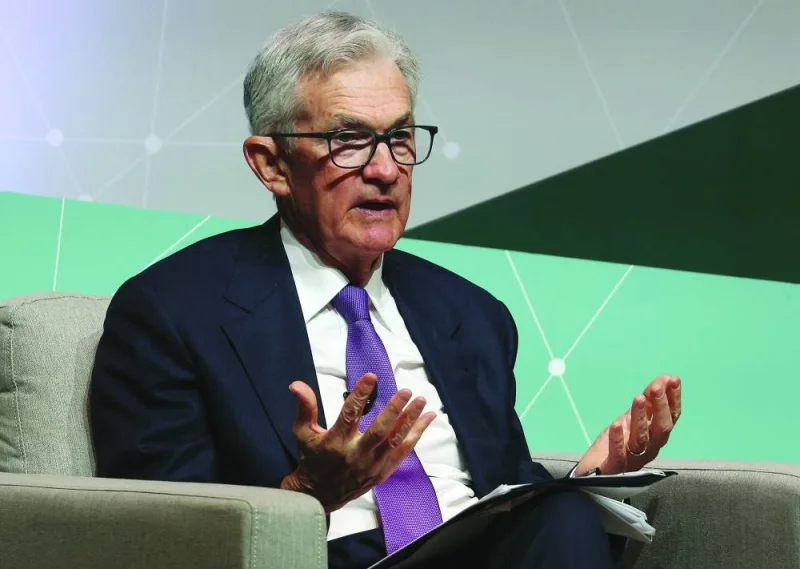East Asia
Fed has time to assess data before deciding to cut rates, says Powell


Federal Reserve Chair Jerome Powell speaks during the Stanford Business, Government and Society Forum at Stanford University in Stanford, California on Wednesday.
Federal Reserve Chair Jerome Powell signalled policymakers will wait for clearer signs of lower inflation before cutting interest rates, even though a recent bump in prices didn’t alter their broader trajectory.
Powell said recent inflation figures — though higher than expected — did not “materially change” the overall picture. He reiterated his expectation that it will likely be appropriate to begin lowering rates “at some point this year.”
“On inflation, it is too soon to say whether the recent readings represent more than just a bump,” Powell said on Wednesday in a speech at Stanford University in California. “We do not expect that it will be appropriate to lower our policy rate until we have greater confidence that inflation is moving sustainably down toward 2%.”
The Federal Open Market Committee held interest rates steady last month. Officials narrowly maintained their outlook for three interest-rate cuts this year, even as key inflation metrics have picked up in 2024. Powell and other Fed officials have repeatedly said they are in no hurry to cut rates, and that their moves will depend on incoming data.
As Chair Powell answered questions following his opening remarks, Treasury yields reversed or pared earlier gains. The S&P 500 remained higher. Investors are putting roughly even odds on an initial cut in June, and pricing suggests they see a chance of fewer than three reductions this year, according to futures.
“Given the strength of the economy and progress on inflation so far, we have time to let the incoming data guide our decisions on policy,” Powell said in the opening remarks ahead of a fireside chat. “If the economy evolves broadly as we expect, most FOMC participants see it as likely to be appropriate to begin lowering the policy rate at some point this year.”
Powell’s prepared remarks reinforce those he’s made following the March meeting. They also suggest that the Fed is unlikely to reduce rates at their next gathering taking place April 30-May 1.
The Fed’s preferred gauge of underlying inflation cooled in February after an even larger increase than previously reported in January, government data released last Friday showed. Even so, the back-to-back increases in the core personal consumption expenditures price index — which excludes volatile food and energy costs — were the biggest in a year.
“Powell still sounds dovish, since the jump in inflation earlier this year might be a blip rather than a new trend,” said Kathy Bostjancic, chief economist at Nationwide Mutual Insurance Co. “His comments support our view that a June rate cut is on the table but we need to see softening in inflation readings starting with the March readings.”
Bostjancic says that as of now, she sees a rate reduction in July as more likely.
Powell said last month that an unexpected weakening in the labour market could warrant a policy response from Fed officials. The Fed will get another update on the health of the job market Friday with the release of the monthly employment report, which is expected to show a gain of 213,000 jobs in March.
Fed officials in March were split on how aggressive rate cuts will be this year. The central bank’s “dot plot” showed 10 officials forecast three or more quarter-point cuts this year, while nine anticipated two or fewer.
Later on Wednesday, Fed Governor Adriana Kugler said she expects inflation can continue to moderate further without a significant cost to jobs or the broader economy.
“If disinflation and labour market conditions proceed as I am currently expecting, then some lowering of the policy rate this year would be appropriate,” she said.
Powell said recent inflation figures — though higher than expected — did not “materially change” the overall picture. He reiterated his expectation that it will likely be appropriate to begin lowering rates “at some point this year.”
“On inflation, it is too soon to say whether the recent readings represent more than just a bump,” Powell said on Wednesday in a speech at Stanford University in California. “We do not expect that it will be appropriate to lower our policy rate until we have greater confidence that inflation is moving sustainably down toward 2%.”
The Federal Open Market Committee held interest rates steady last month. Officials narrowly maintained their outlook for three interest-rate cuts this year, even as key inflation metrics have picked up in 2024. Powell and other Fed officials have repeatedly said they are in no hurry to cut rates, and that their moves will depend on incoming data.
As Chair Powell answered questions following his opening remarks, Treasury yields reversed or pared earlier gains. The S&P 500 remained higher. Investors are putting roughly even odds on an initial cut in June, and pricing suggests they see a chance of fewer than three reductions this year, according to futures.
“Given the strength of the economy and progress on inflation so far, we have time to let the incoming data guide our decisions on policy,” Powell said in the opening remarks ahead of a fireside chat. “If the economy evolves broadly as we expect, most FOMC participants see it as likely to be appropriate to begin lowering the policy rate at some point this year.”
Powell’s prepared remarks reinforce those he’s made following the March meeting. They also suggest that the Fed is unlikely to reduce rates at their next gathering taking place April 30-May 1.
The Fed’s preferred gauge of underlying inflation cooled in February after an even larger increase than previously reported in January, government data released last Friday showed. Even so, the back-to-back increases in the core personal consumption expenditures price index — which excludes volatile food and energy costs — were the biggest in a year.
“Powell still sounds dovish, since the jump in inflation earlier this year might be a blip rather than a new trend,” said Kathy Bostjancic, chief economist at Nationwide Mutual Insurance Co. “His comments support our view that a June rate cut is on the table but we need to see softening in inflation readings starting with the March readings.”
Bostjancic says that as of now, she sees a rate reduction in July as more likely.
Powell said last month that an unexpected weakening in the labour market could warrant a policy response from Fed officials. The Fed will get another update on the health of the job market Friday with the release of the monthly employment report, which is expected to show a gain of 213,000 jobs in March.
Fed officials in March were split on how aggressive rate cuts will be this year. The central bank’s “dot plot” showed 10 officials forecast three or more quarter-point cuts this year, while nine anticipated two or fewer.
Later on Wednesday, Fed Governor Adriana Kugler said she expects inflation can continue to moderate further without a significant cost to jobs or the broader economy.
“If disinflation and labour market conditions proceed as I am currently expecting, then some lowering of the policy rate this year would be appropriate,” she said.







